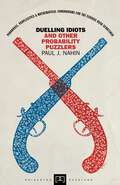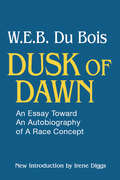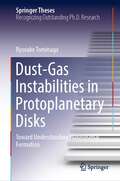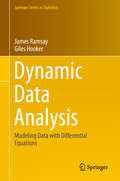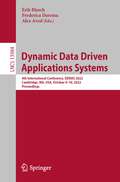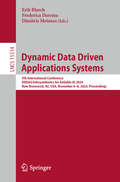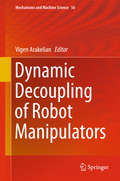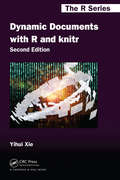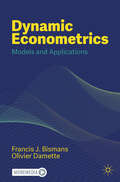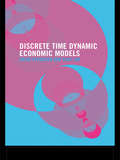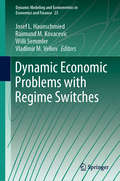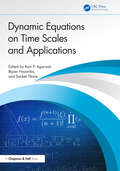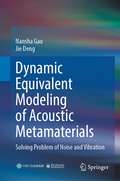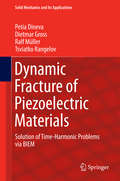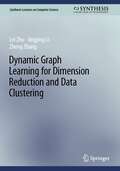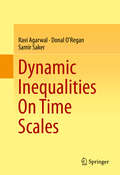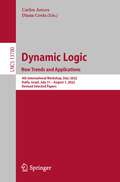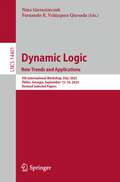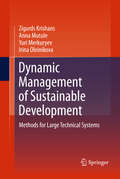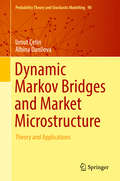- Table View
- List View
Duelling Idiots and Other Probability Puzzlers (Princeton Puzzlers)
by Paul J. NahinWhat are your chances of dying on your next flight, being called for jury duty, or winning the lottery? We all encounter probability problems in our everyday lives. In this collection of twenty-one puzzles, Paul Nahin challenges us to think creatively about the laws of probability as they apply in playful, sometimes deceptive, ways to a fascinating array of speculative situations. Games of Russian roulette, problems involving the accumulation of insects on flypaper, and strategies for determining the odds of the underdog winning the World Series all reveal intriguing dimensions to the workings of probability. Over the years, Nahin, a veteran writer and teacher of the subject, has collected these and other favorite puzzles designed to instruct and entertain math enthusiasts of all backgrounds. If idiots A and B alternately take aim at each other with a six-shot revolver containing one bullet, what is the probability idiot A will win? What are the chances it will snow on your birthday in any given year? How can researchers use coin flipping and the laws of probability to obtain honest answers to embarrassing survey questions? The solutions are presented here in detail, and many contain a profound element of surprise. And some puzzles are beautiful illustrations of basic mathematical concepts: "The Blind Spider and the Fly," for example, is a clever variation of a "random walk" problem, and "Duelling Idiots" and "The Underdog and the World Series" are straightforward introductions to binomial distributions. Written in an informal way and containing a plethora of interesting historical material, Duelling Idiots is ideal for those who are fascinated by mathematics and the role it plays in everyday life and in our imaginations.
Dusk of Dawn!: An Essay Toward an Autobiography of Race Concept (The\library Of America)
by W. E. DuBoisIn her perceptive introduction to this edition, Irene Diggs sets this classic autobiography against its broad historical context and critically analyzes its theoretical and methodological significance.
Dust-Gas Instabilities in Protoplanetary Disks: Toward Understanding Planetesimal Formation (Springer Theses)
by Ryosuke TominagaHow planets form is one of the long-standing questions in astrophysics. In particular, formation scenarios of planetesimals which are kilometer-sized bodies and a precursor of planets are still unclear and under debate although some promising mechanisms have been proposed.This book highlight disk instabilities that have the potential to explain the origin of planetesimals. Using linear analyses and numerical simulations, it addresses how a disk evolves through the development of instabilities, and also presents a new instability driven by dust coagulation. As a result, the simulation demonstrates a scenario of planetesimal formation: A successive development of multiple instabilities triggers planetesimal formation in resulting dusty rings.
Dynamic Data Analysis
by James Ramsay Giles HookerThis text focuses on the use of smoothing methods for developing and estimating differential equations following recent developments in functional data analysis and building on techniques described in Ramsay and Silverman (2005) Functional Data Analysis. The central concept of a dynamical system as a buffer that translates sudden changes in input into smooth controlled output responses has led to applications of previously analyzed data, opening up entirely new opportunities for dynamical systems. The technical level has been kept low so that those with little or no exposure to differential equations as modeling objects can be brought into this data analysis landscape. There are already many texts on the mathematical properties of ordinary differential equations, or dynamic models, and there is a large literature distributed over many fields on models for real world processes consisting of differential equations. However, a researcher interested in fitting such a model to data, or a statistician interested in the properties of differential equations estimated from data will find rather less to work with. This book fills that gap.
Dynamic Data Driven Applications Systems: 4th International Conference, DDDAS 2022, Cambridge, MA, USA, October 6–10, 2022, Proceedings (Lecture Notes in Computer Science #13984)
by Erik Blasch Alex Aved Frederica DaremaThis book constitutes the refereed proceedings of the 4th International Conference on Dynamic Data Driven Applications Systems, DDDAS 2022, which took place in Cambridge, MA, USA, during October 6–10, 2022.The 31 regular papers in the main track and 5 regular papers from the Wildfires panel, as well as one workshop paper, were carefully reviewed and selected for inclusion in the book. They were organized in following topical sections: DDAS2022 Main-Track Plenary Presentations; Keynotes; DDDAS2022 Main-Track: Wildfires Panel; Workshop on Climate, Life, Earth, Planets.
Dynamic Data Driven Applications Systems: 5th International Conference, DDDAS/Infosymbiotics for Reliable AI 2024, New Brunswick, NJ, USA, November 6–8, 2024, Proceedings (Lecture Notes in Computer Science #15514)
by Dimitris Metaxas Erik Blasch Frederica DaremaThis book constitutes the refereed proceedings of the 5th International Conference on Dynamic Data Driven Applications Systems, DDDAS/Infosymbiotics for Reliable AI 2024, held in New Brunswick, NJ, USA, during November 6–8, 2024. The 43 full papers included in this book were carefully reviewed and selected from 52 submissions. By combining DDDAS and typical AI approaches, the papers address state-of-the-art efforts to create frameworks for enabling new and advanced Science and Technology capabilities to address challenges and create opportunities in important areas, spanning a wide set of areas, such as: materials and aerospace systems; communications networks; energy infrastructures; cyber-security; adverse environmental situations; societal dynamics; computer vision; robotics; laboratory automation; bio-informatics and pharmaceuticals design; and more.
Dynamic Decoupling of Robot Manipulators
by Vigen ArakelianThis book presents the latest results in the field of dynamic decoupling of robot manipulators obtained in France, Russia, China and Austria.Manipulator dynamics can be highly coupled and nonlinear. The complicated dynamics result from varying inertia, interactions between the different joints, and nonlinear forces such as Coriolis and centrifugal forces. The dynamic decoupling of robot manipulators allows one to obtain a linear system, i.e. single-input and single output system with constant parameters. This simplifies the optimal control and accumulation of energy in manipulators. There are two ways to create the dynamically decoupled manipulators: via optimal mechanical design or control.This work emphasises mechatronic solutions. These will certainly improve the known design concepts permitting the dynamic decoupling of serial manipulators with a relatively small increase in total mass of the moving links taking into account the changing payload. For the first time such an approach has been applied on serial manipulators. Also of great interest is the dynamic decoupling control of parallel manipulators. Firstly, the dynamic model of redundant multi-axial vibration table with load has been established, and, secondly, its dynamic coupling characteristics have been analyzed. The discussed methods and applications of dynamic decoupling of robot manipulators are illustrated via CAD simulations and experimental tests.
Dynamic Demographic Analysis
by Robert SchoenThis volume presents state of the art analyses from scholars dealing with a range of demographic topics of current concern, including longevity, mortality and morbidity, migration, and how population composition impacts intergenerational transfer schemes. New approaches are applied to such issues as measuring changes in cohort survivorship in low mortality populations, patterns of mortality improvement at older ages, and the consequences of heterogeneity in the susceptibility to death. Studies examine models of the current status of the HIV/AIDS epidemic, advance present methods for estimating population change in small areas, and strive to disentangle age, period, and cohort effects. In sum, the book addresses key contemporary issues in measuring and modeling dynamic populations, and advances the frontier of dynamic demography.
Dynamic Documents with R and knitr (Chapman & Hall/CRC The R Series #12)
by Yihui XieQuickly and Easily Write Dynamic Documents Suitable for both beginners and advanced users, Dynamic Documents with R and knitr, Second Edition makes writing statistical reports easier by integrating computing directly with reporting. Reports range from homework, projects, exams, books, blogs, and web pages to virtually any documents related to statistical graphics, computing, and data analysis. The book covers basic applications for beginners while guiding power users in understanding the extensibility of the knitr package. New to the Second Edition A new chapter that introduces R Markdown v2 Changes that reflect improvements in the knitr package New sections on generating tables, defining custom printing methods for objects in code chunks, the C/Fortran engines, the Stan engine, running engines in a persistent session, and starting a local server to serve dynamic documents Boost Your Productivity in Statistical Report Writing and Make Your Scientific Computing with R Reproducible Like its highly praised predecessor, this edition shows you how to improve your efficiency in writing reports. The book takes you from program output to publication-quality reports, helping you fine-tune every aspect of your report.
Dynamic Econometrics: Models and Applications
by Francis J. Bismans Olivier DametteThis textbook for advanced econometrics students introduces key concepts of dynamic non-stationary modelling. It discusses all the classic topics in time series analysis and linear models containing multiple equations, as well as covering panel data models, and non-linear models of qualitative variables. The book offers a general introduction to dynamic econometrics and covers topics including non-stationary stochastic processes, unit root tests, Monte Carlo simulations, heteroskedasticity, autocorrelation, cointegration and error correction mechanism, models specification, and vector autoregressions. Going beyond advanced dynamic analysis, the book also meticulously analyses the classical linear regression model (CLRM) and introduces students to estimation and testing methods for the more advanced auto-regressive distributed lag (ARDL) model. The book incorporates worked examples, algebraic explanations and learning exercises throughout. It will be a valuable resource for graduate and postgraduate students in econometrics and quantitative finance as well as academic researchers in this area.
Dynamic Economic Analysis
by Gerhard SorgerFocusing on deterministic models in discrete time, this concise yet rigorous textbook provides a clear and systematic introduction to the theory and application of dynamic economic models. It guides students through the most popular model structures and solution concepts, from the simplest dynamic economic models through to complex problems of optimal policy design in dynamic general equilibrium frameworks. Chapters feature theorems and practical hints, and 75 worked examples highlight the various methods and results that can be applied in dynamic economic models. Notation and formulation is uniform throughout, enabling students to easily discern the similarities and differences between various model classes. Chapters include more than 60 exercises for students to self-test their analytical skills, and password-protected solutions are available for instructors on the companion website. Assuming no prior knowledge of dynamic economic analysis or dynamic optimization, this textbook is ideal for advanced students in economics.
Dynamic Economic Models in Discrete Time: Theory and Empirical Applications
by Brian Ferguson Guay LimThis new book will be welcomed by econometricians and students of econometrics everywhere. Introducing discrete time modelling techniques and bridging the gap between economics and econometric literature, this ambitious book is sure to be an invaluable resource for all those to whom the terms unit roots, cointegration and error correction forms, ch
Dynamic Economic Problems with Regime Switches (Dynamic Modeling and Econometrics in Economics and Finance #25)
by Willi Semmler Vladimir M. Veliov Raimund M. Kovacevic Josef L. HaunschmiedThis book presents the state of the art in the relatively new field of dynamic economic modelling with regime switches. The contributions, written by prominent scholars in the field, focus on dynamic decision problems with regime changes in underlying dynamics or objectives. Such changes can be externally driven or internally induced by decisions. Utilising the most advanced mathematical methods in optimal control and dynamic game theory, the authors address a broad range of topics, including capital accumulation, innovations, financial decisions, population economics, environmental and resource economics, institutional change and the dynamics of addiction. Given its scope, the book will appeal to all scholars interested in mathematical and quantitative economics.
Dynamic Equations on Time Scales and Applications
by Ravi P. Agarwal Bipan Hazarika Sanket TikareThis book presents the theory of dynamic equations on time scales and applications, providing an overview of recent developments in the foundations of the field as well as its applications. It discusses the recent results related to the qualitative properties of solutions like existence and uniqueness, stability, continuous dependence, controllability, oscillations, etc. Presents cutting-edge research trends of dynamic equations and recent advances in contemporary research on the topic of time scales Connects several new areas of dynamic equations on time scales with applications in different fields Includes mathematical explanation from the perspective of existing knowledge of dynamic equations on time scales Offers several new recently developed results, which are useful for the mathematical modeling of various phenomena Useful for several interdisciplinary fields like economics, biology, and population dynamics from the perspective of new trends The text is for postgraduate students, professionals, and academic researchers working in the fields of Applied Mathematics
Dynamic Equivalent Modeling of Acoustic Metamaterials: Solving Problem of Noise and Vibration
by Nansha Gao Jie DengThis book derives physical models from basic principles, studies the effect of equivalent models on the dynamic characteristics of phononic crystals and acoustic metamaterials, and analyzes the physical mechanisms behind vibration and noise reduction. It first summarizes the research status of vibration and noise reduction, and research progress in phononic crystals and acoustic metamaterials. Based on this, one-dimensional periodic beam, two-dimensional thin plate with circular hole, and corresponding gradient structures are introduced, and their dynamic characteristics are discussed in detail. Therefore, different equivalent methods for different models are proposed through theoretical analysis, modal analysis and transmission rate analysis. Finally, a Helmholtz-type acoustic metamaterial, i.e. a multi-layer slotted tube acoustic metamaterial, is studied. Aiming at the low-frequency band gap of this model, a theoretical model for solving the inverse problem of acousto-electric analogue equivalent is proposed, and the effect of structural parameters on the low-frequency band gap is studied using this equivalent model. This book closely revolves around how to conduct equivalent research on artificially fabricated periodic structures. The methods and conclusions presented in this book provide a new theoretical basis for the application of artificial woven periodic structures in the field of low-frequency vibration reduction and noise reduction and are also an innovation in the discipline of vibration and noise control. This book is suitable for undergraduate students, graduate students and teachers in vibration and noise majors in universities, and can also provide references for engineering and technical personnel in related fields.
Dynamic Flowsheet Simulation of Solids Processes
by Stefan HeinrichThis book presents the latest advances in flowsheet simulation of solids processes, focusing on the dynamic behaviour of systems with interconnected solids processing units, but also covering stationary simulation. The book includes the modelling of solids processing units, for example for comminution, sifting and particle formulation and also for reaction systems. Furthermore, it examines new approaches for the description of solids and their property distributions and for the mathematical treatment of flowsheets with multivariate population balances.
Dynamic Fracture of Piezoelectric Materials
by Petia Dineva Dietmar Gross Ralf Müller Tsviatko RangelovDynamic Fracture of Piezoelectric Materials focuses on the Boundary Integral Equation Method as an efficient computational tool. The presentation of the theoretical basis of piezoelectricity is followed by sections on fundamental solutions and the numerical realization of the boundary value problems. Two major parts of the book are devoted to the solution of problems in homogeneous and inhomogeneous solids. The book includes contributions on coupled electro-mechanical models, computational methods, its validation and the simulation results, which reveal different effects useful for engineering design and practice. The book is self-contained and well-illustrated, and it serves as a graduate-level textbook or as extra reading material for students and researchers.
Dynamic Geometry on Time Scales
by Svetlin G. GeorgievThis book introduces plane curves on time scales. They are deducted the Frenet equations for plane and space curves. In the book is presented the basic theory of surfaces on time scales. They are defined tangent plane, \sigma_1 and \sigma_2 tangent planes, normal, \sigma_1 and \sigma_2 normals to a surface. They are introduced differentiable maps and differentials on surface. This book provides the first and second fundamental forms of surfaces on time scales. They are introduced minimal surfaces and geodesics on time scales. In the book are studied the covaraint derivatives on time scales, pseudo-spherical surfaces and \sigma_1, \sigma_2 manifolds on time scales.
Dynamic Graph Learning for Dimension Reduction and Data Clustering (Synthesis Lectures on Computer Science)
by Lei Zhu Zheng Zhang Jingjing LiThis book illustrates how to achieve effective dimension reduction and data clustering. The authors explain how to accomplish this by utilizing the advanced dynamic graph learning technique in the era of big data. The book begins by providing background on dynamic graph learning. The authors discuss why it has attracted considerable research attention in recent years and has become well recognized as an advanced technique. After covering the key topics related to dynamic graph learning, the book discusses the recent advancements in the area. The authors then explain how these techniques can be practically applied for several purposes, including feature selection, feature projection, and data clustering.
Dynamic Inequalities On Time Scales
by Donal O'Regan Ravi Agarwal Samir SakerThis is a monograph devoted to recent research and results on dynamic inequalities on time scales. The study of dynamic inequalities on time scales has been covered extensively in the literature in recent years and has now become a major sub-field in pure and applied mathematics. In particular, this book will cover recent results on integral inequalities, including Young's inequality, Jensen's inequality, Holder's inequality, Minkowski's inequality, Steffensen's inequality, Hermite-Hadamard inequality and Čebysv's inequality. Opial type inequalities on time scales and their extensions with weighted functions, Lyapunov type inequalities, Halanay type inequalities for dynamic equations on time scales, and Wirtinger type inequalities on time scales and their extensions will also be discussed here in detail.
Dynamic Logic. New Trends and Applications: 4th International Workshop, DaLí 2022, Haifa, Israel, July 31–August 1, 2022, Revised Selected Papers (Lecture Notes in Computer Science #13780)
by Carlos Areces Diana CostaThis book constitutes revised selected papers from the refereed proceedings of the 4th International Workshop on Dynamic Logic, DaLí 2022, held in Haifa, Israel, in July/August 2022.The 8 full papers presented in this volume were carefully reviewed and selected from 22 submissions. They deal with new trends and applications in the area of Dynamic Logic.
Dynamic Logic. New Trends and Applications: 5th International Workshop, DaLí 2023, Tbilisi, Georgia, September 15–16, 2023, Revised Selected Papers (Lecture Notes in Computer Science #14401)
by Nina Gierasimczuk Fernando R. Velázquez-QuesadaThis book constitutes the revised selected papers of the 5th International Workshop on Dynamic Logic. New Trends and Applications, DaLí 2023, held in Tbilisi, Georgia, during September 15–16, 2023. The 8 full papers in this book were carefully reviewed and selected from 10 submissions. They deal with new trends and applications in the area of Dynamic Logic.
Dynamic Management of Sustainable Development
by Irina Oleinikova Anna Mutule Yuri Merkuryev Zigurds KrishansDynamic management of systems development is a precondition for the realization of sustainable system development. This approach allows for the usage of systems theory methods that take into consideration the interaction of decisions made over time and space. A characteristic feature of this kind of method is that the process of sophisticated object development over time is examined for optimal decision selection. This requires the application of modelling methods that represent properties of the developing objects, high speed calculation methods for the estimation of technical and economic characteristics, as well as effective optimization methods. Dynamic Management of Sustainable Development presents a concise summary of the authors' research in the area of dynamic methods analysis of technical systems development. Along with systematic illustration of mathematical methods, considerable attention is drawn to practical realization and applications. Dynamic Management of Sustainable Development will be helpful for scientists involved in the mathematical modelling of large technical systems development and for engineers working in the area of large technical systems planning.
Dynamic Markov Bridges and Market Microstructure: Theory And Application (Probability Theory and Stochastic Modelling #90)
by Umut Çetin Albina DanilovaThis book undertakes a detailed construction of Dynamic Markov Bridges using a combination of theory and real-world applications to drive home important concepts and methodologies. In Part I, theory is developed using tools from stochastic filtering, partial differential equations, Markov processes, and their interplay. Part II is devoted to the applications of the theory developed in Part I to asymmetric information models among financial agents, which include a strategic risk-neutral insider who possesses a private signal concerning the future value of the traded asset, non-strategic noise traders, and competitive risk-neutral market makers. A thorough analysis of optimality conditions for risk-neutral insiders is provided and the implications on equilibrium of non-Gaussian extensions are discussed.A Markov bridge, first considered by Paul Lévy in the context of Brownian motion, is a mathematical system that undergoes changes in value from one state to another when the initial and final states are fixed. Markov bridges have many applications as stochastic models of real-world processes, especially within the areas of Economics and Finance. The construction of a Dynamic Markov Bridge, a useful extension of Markov bridge theory, addresses several important questions concerning how financial markets function, among them: how the presence of an insider trader impacts market efficiency; how insider trading on financial markets can be detected; how information assimilates in market prices; and the optimal pricing policy of a particular market maker.Principles in this book will appeal to probabilists, statisticians, economists, researchers, and graduate students interested in Markov bridges and market microstructure theory.
